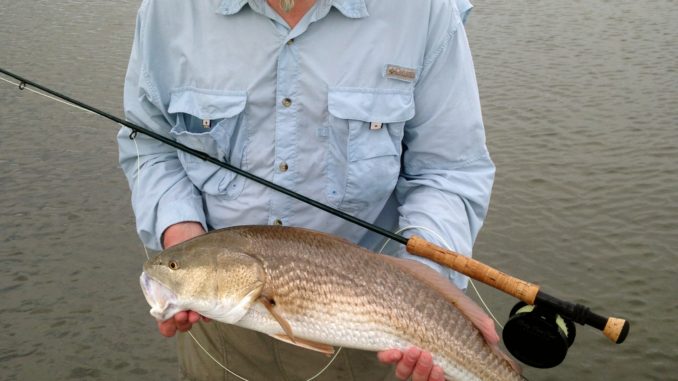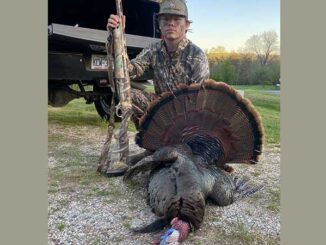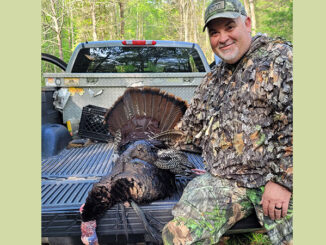
Georgetown, S.C., anglers can start targeting tailing redfish this month as the flood-tide marshes fill up with water and redfish.
June is one of the best months to enjoy South Carolina’s outdoors by targeting a finned foe with a hook and line. And for purists willing to give up modern technology for custom, feathered creations, the ultimate adventure takes place this month, when an angler’s spot-tailed prize is served tails up in just inches of water.
Saltwater fly fishing is gaining ground around the United States and especially in South Carolina waters. For Jeff Lattig of Georgetown’s Living Water Guide Service, slinging a chunk of deer fur jeweled with silky feathers at a bronzed redfish is his preference and his specialty.
“You can be at a disadvantage with putting feathers on a hook,” said Lattig, “but one fish on the tailing flats with a fly is well worth the effort. It’s awesome.”
Redfish can be caught many ways and at different stages of the tide, but the rare flood tides are a fly caster’s dream. Flood tides occur close to the full and new moon phases, the result of the gravitational effects from the moon’s position and its orbit. Places that don’t normally get wet will flood during these strong tidal sequences. That’s exceptionally good news for redfish, because one of their favorite foods, the fiddler crab, loses its high-ground refuge. Those marsh islands that normally stay dry become feeding grounds for redfish.
In the Georgetown area, prime tailing flats can occur anywhere from just behind the barrier islands to the remote backwater hummocks many miles from the ocean. Lattig chooses high-water flats adjacent to his favorite low-water places to look for tailers.
“Redfish will move up on flats adjacent to where I find them concentrated on low water,” Lattig said. “The hard-bottom flats with short grass make the best tailing flats.”
Flood waters can open up travel lanes for redfish to go about anywhere during high-water situations that can make predictable places unpredictable.
“They move around a good bit on high water,” he said.
Time is of the essence when looking for tailing fish. The tides rise and fall more during the same amount of time, so currents will be significantly stronger and the water won’t just creep up on the flats.
“The window is very short, especially on the bigger 6.2- to 6.5-foot tides. They move in fast and hard, which is why I prefer a tide prediction of 5.7 to 6.0. They are slower on the rise,” Lattig said.
Typically, the flats flood from one or two access points, and as the tide rises, the water creeps up on the flats, expanding the feeding territory. Lattig will identify with these access points and start fishing those areas first.
“Fish will hang close to the areas where they normally feed. When they enter a flat, they will usually use the same point to enter and exit,” he said.
Mark Young, the head guide of Hobcaw Fly Fishing Adventures, takes clients on foot into the untouched wilderness behind Hobcaw Barony on the extreme southern end of the Grand Strand. He likes to access these waters from the marsh side and will get to cast a fly as soon as these flats fill up with enough water for these fish to navigate.
“The Hobcaw area is so good for us to target these fish on foot,” Young said. “The tailing flats near Hobcaw are remote, and because they are untouched, the fish don’t get spooked in the deeper areas before the water makes it onto the short-grassed flats.”
While fish are feeding on the flats, they alert anglers of their presence when they dive face-first into the mud after a crab, with their tails breaking the surface. Young watches the places that fish use to slip onto the flats to hunt for fiddler crabs.
“Reds will take blue crabs, mud crabs and minnows, but the fiddler is the key on these flats,” Young said, who likes to create things on his fly-tying vice that are bulky and look like a fiddler crab or jumbo shrimp.
“My top flies for tailing fish are the Copper Crab, Fire Cracker and the Meatball. All of these flies are custom creations I tie, but are all tied in sizes and colors roughly resembling a fiddler crab,” he said.
According to Lattig, the fly doesn’t necessarily need to match the hatch with perfect colors and shapes of a natural critter.
“They will eat anything that they stir up that is trying to escape. If they can see it, they are going to pounce on it,” he said, explaining that when reds are tailing hard, they will muddy up the water, and highly visible flies are key to grabbing their attention.
“I like burnt orange ; that looks like the hinge on the crab’s carapace — and really any other color they can see well, but a combination of purple and black or copper and gold are hard to beat. When they are tailing real hard, I will even throw a flashy spoon fly at them and get eaten quick,” Young said.
One of the biggest mistakes anglers make is to overcast and overwork flies or lures to approaching fish. The natural reaction for most crustaceans is to remain still when danger is present.
Crabs instinctively sit still when danger is present. Let the bright colors and the characteristics of the fly do the work. Too many times, anglers will strip the fly towards the fish to make sure the fish can see it, and this is not a natural behavior.
“I will cast the fly in the clean water and let it sit still like it is dead. As soon as they see the fly, it is over and they will kill it,” Young said. “If you twitch the fly towards the fish, he will spook. Prey never comes to the fish. If you want to strip it, strip away from the fish to get the predator-prey relationship.”
Redfish are caught in many ways throughout the year. Sight-fishing for them, fly rod in hand, during unusually high, flood tides as about as good as it gets for an inshore angler.
DESTINATION INFORMATION
HOW TO GET THERE — US 17 and US 701 are the main roads that bring fishermen to Georgetown. The tailing flats around the city are accessible from several public boat ramps, including South Island Ferry on South Island Road southeast of town, East Bay Park adjacent to the ballpark in downtown Georgetown, and the Campbell Marine Complex next to the US 17 bridge at the mouth of the Sampit River.
WHEN TO GO — Tailing reds are caught on the high tides closest to the full moons from June through November. Look for any tide greater than 5.7 feet to push water onto flats. Wind is a contributing factor; west winds will push water into the ocean, and east winds will push water into the estuaries. Reds will feed ferociously as soon as water rushes onto the flats; tailing action may last two or three hours.
BEST TECHNIQUES — A wide variety of flies will dupe redfish on tidal flats, but fiddler crab imitations are the best option. The best colors are bright, and like orange, gold/copper, blue, and black/purple. Toad flies are also good choices with extra, untrimmed deer hair and craft fur. More important is being able to put the fly in front of reds and keep it still. Topwater gurglers will work best in staging pools. Use 9- to 10-foot, 8- to 10-weight fly rods and reels spooled with weight-forward, floating line and leaders at least 7 1/2 feet long, including a 2-foot tippet of 20-pound fluorocarbon.
FISHING INFO/GUIDES — Mark Young, Hobcaw Fly Fishing Adventures, 843-685-6725, www.hobcawflyfishing.com; Jeff Lattig, Living Water Guide Service, 843-997-4655, www.livingwaterguide.com. See also Guides and Charters in Classifieds.
ACCOMMODATIONS — Georgetown Area Visitors Center, www.visitgeorgetown.com; Myrtle Beach Area Convention and Visitors Bureau, www.mbchamber.com; South Carolina Association of Visitors Bureaus, www.discoversouthcarolina.com.
MAPS — Navionics, www.navionics.com, 800-848-5896; Delorme S.C. Atlas and Gazetteer, 800-561-5105, www.delorme.com; Capt. Seagull’s Nautical Charts, 888-473-4855, www.captainsegullcharts.com.







Be the first to comment